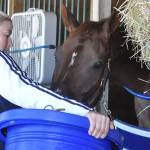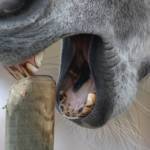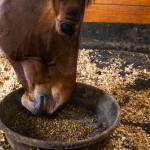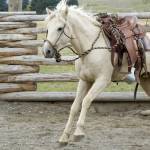Endurance Riding Requires a Will to Run

To run a marathon is a solitary endeavor. Even when you are surrounded by other competitors, you are competing with yourself to finish. Winning is a secondary goal. You run to finish and no one who enters the race considers that they won’t,” said Jeff Thompson, who has completed many marathons but considers his completion of the 1999 New York City Marathon a highlight of his career.
“Most competitors in an endurance race are there to finish. Oh, there are some that are there to win, but most are there to finish. No one enters the race if they think they won’t. Winning is great, but finishing in itself is a victory,” explained Yvette Vinton, DVM, a member of the Canadian Pan Am Games endurance team and a rider who has competed in endurance races all over the world.
The difference between these athletes is that Mr. Thompson runs his race as an individual, while Dr. Vinton is part of a team. That description doesn’t quite hit the mark. The word team implies a coordinated effort between two similarly matched participants. Only in an equine sport would the members of the team be so diverse. Dr. Vinton must protect, push, encourage, and assist her partner, an animal of almost 1,000 pounds that knows only how to cover ground – lots of it – as fast as possible. Dr. Nancy Loving, an endurance competitor, judge, and veterinarian, likens the connection between the horse and rider to the mythical centaur, a beast fabled to be half horse and half man. Perhaps it is the sheer number of hours spent in preparation and competition that solidifies this impression. Possibly it is the uniqueness of the athletes who are drawn to endurance riding, one of the world’s fastest growing and most grueling equine sports.
Endurance riding received official recognition from the Federation Equestre Internationale (FEI), the international governing body of equestrian sports, in the early 1950s. Since that time, the number of races throughout the world has grown, as has the number of people involved in the sport.
There are many levels of endurance competitions, ranging from short rides 25 miles or less to 250- mile races run over five days. International events typically involve 100-mile courses run in one day that are divided by mandatory veterinary inspections to insure the health and safety of the equine competitors. Stringent rules provide specific guidelines for officiating veterinarians to follow when judging a horse’s ability to continue the race. The horses’ respiratory and heart rates are monitored, feet and legs are carefully examined for signs of problems that could lead to lameness, and the horse is assessed for signs of dehydration. Any problem in one of these areas can cause a horse to be eliminated from the competition, and many are either withdrawn by their riders or eliminated at the veterinary checks. At the 2001 Tevis Cup, a particularly arduous endurance competition held in California, 225 entries began the race and only 91 finished.

For those horses and riders in the upper echelons of the sport, resourcefulness, resilience, and courage are mandatory. It takes a strong, well conditioned horse and rider to face the grueling and often varied terrain of some of the elite endurance races. A horse that wins at this level may have competed in Dubai, where the sandsprovide a hard-packed surface in some areas and soft footing in others, and in the western United States, where horses can travel through 19,000 feet of altitude changes in one race. Differences in heat and humidity play a factor as well. An endurance team will often need to spend time acclimating to the area where the race will be held prior to competing, which leads to yet another form of resourcefulness – financing.
Top athletes in this sport must train consistently either at home or when traveling. Dr. Vinton described financing this exacting regimen as a “balancing act. It is hard to juggle the amount of time it takes to train with the amount of time needed to work to support yourself and your horses.” Travel costs can dip heavily into the wallet of even the best-heeled enthusiast. Fortunately for the endurance world, some of its staunchest supporters are the sheiks of the United Arab Emirates (UAE). Their sponsorship of the sport and generosity made it possible for the 1998 World Endurance Championship, held in Dubai, to see the largest collection of countries (37) ever represented at an equine world competition. This event, and subsequent races subsidized by UAE enthusiasts, have elevated the profile of endurance competitions and have been responsible for bringing more people into the sport.
Dr. Ray Randall, a veterinarian from Montana with years of experience as an international endurance race official, mentioned that the UAE involvement has raised the stakes considerably for many endurance enthusiasts in a number of ways. He explained, “It used to be that a good endurance prospect could be purchased for a small or relatively reasonable amount of money. Now, with more people looking for those types of horses, and some of those people being able to spend a good amount of money, the price tag has gone up. Also, there is more prize money involved than ever before, and that is a drawing card.”
Dr. Randall described another change. “The sheiks are able to pair the right rider for the right horse. While many ride their own horses, they may also have more than one horse entered, so they need a very good catch rider or they may even pay jockeys to ride their other horses. This has had a considerable impact on the sport.”
Because of the increasing number of endurance races throughout the world, there are more opportunities for people consumed by the sport to participate. However, a horse can only complete so many 100-mile races in one year. As a result people like Linda Crandell, a member of one of the most involved families in the sport, often travel the world over as catch riders. Mrs. Crandell, her husband, sons, and a daughter-in-law have all had the opportunity to enter endurance races on horses belonging to foreign endurance enthusiasts. Mrs. Crandell’s interest in the sport began in 1978 when her husband entered a Tennessee Walking Horse in a race in New York. She competed for the first time in 1980 and began winning almost immediately because, as she put it, “I had this absolutely incredible horse that had a racing trot that was hard to beat.” She was hooked and has been an avid enthusiast of the sport ever since.
Mrs. Crandell and some of her relatives have spent months training in Dubai and riding horses belonging to various members of the UAE Endurance Committee. She, like Dr. Randall, feels that the contribution these horsemen have made to the sport has been instrumental in raising the awareness of endurance riding and bringing more monetary incentive into breeding programs and sweepstakes. She also credits them with providing exceptional care for their animals. She stated, “Sheik Hamdan flew my son over to Dubai to do some blacksmith work on his horses. I had the opportunity to go as well, and we were able to help in his training program. One horse I rode was from Australia and was very fit. It had won eight straight 30-mile races.”
The winner of the FEI/UAE Worlds Most Preferred Race in March of last year is another good example of the international flavor of endurance competitions and the involvement of the UAE Endurance Committee. Everly De Quivarch, a mare of French origin, owned by H.H. Sheik Mohammed bin Rashid Al Maktoum, was ridden by Abdullah Bilhab of Dubai and trained by Erwann Droumaget of France. Yet another example is Canadian Dr. Vinton, who competed at the 2000 World Endurance Championship in France on a horse imported from Australia by his new English owners. With few exceptions, most of the horses that excel at this sport, regardless of their country of origin, have genetic roots that trace back to ancestors that traversed desert sands. The vast majority of these horses are of Arabian extraction.
Mrs. Crandell explained, “These horses have large nostrils and lung capacities that allow for greater oxygen intake. Arabians have veins that are close to the skin surface, which help in cooling the blood and allowing for quicker recovery times. They are a slighter horse with lighter muscling that makes it easier for them to carry themselves and their riders over longer distances.”
Still, not every Arabian or Arabian cross makes a winning endurance horse. Dr. Vinton, who owns two Arabians, WW Due Me and EH Malachi, said, “It is important to look for specific conformation traits that will make the horse better suited to the sport. Due Me has terrific hindquarters and a huge motor. Malachi is small but well put together. What really made them standouts for me were their attitudes and personalities. These horses have to be competitive. They have to like to pass that other horse. Sometimes they can have too much heart and will go beyond what they should. That is when the rider has to step in and protect the horse. If they don’t have the heart and will to drive themselves, they will not succeed in this sport.”
“Heart” is the one trait that horsemen across many equine disciplines search to find and define. It cannot be seen or measured, but, according to Mrs. Crandell, “If it is there to begin with, it can be further developed. Too much heart is almost more of a problem than not enough. I almost prefer a young horse to be a little bit lazy. They will be easier to protect than a horse that just wants to push ahead. That horse will leave his race in the early miles, whereas the more deliberate horse will still be there at the end of it.”
A horse that exemplifies heart for the Crandell family is Bold Soldier, a 22-year-old Arabian stallion that competed in endurance races until he suffered a kick from another horse at the age of 19. He will cover a full book of mares this season and is being conditioned to compete again. He has passed his unique blend of conformation and heart on to many of his progeny. Mrs. Crandell said, “Usually, by the time our horses are two-year olds, we know which ones will be most likely to make endurance horses.
We look for conformation and temperament, and then we slowly work at conditioning them. If we think they have it within their ability to be horses that can compete at the highest levels, we continue on with our training. If not, we sell them to people who still want a nice horse, but aren’t interested in going quite as far in the sport. The horses we keep are then conditioned to compete. We may not push them to be in the lead; in fact, we try not to be in the lead for the first few races, so that we can teach them to rate themselves and listen to their rider.
Then, if they keep progressing well, we will push them to win. I want to win. I can’t imagine why I would enter a race if I didn’t, but I would never want to win at the expense of the horse. Finishing a 100-mile race is also a victory.”
Horses with all the physical and mental attributes necessary to compete in endurance competitions still need riders that can judge pace and choose the most advantageous routes through the course. Dr. Randall quoted an often used phrase in endurance riding: “A good horse ridden smart will beat a great horse ridden stupid every time.”
At the highest levels of the sport, riders have a great deal of assistance provided by a knowledgeable crew of people that can offer encouragement and veterinary and farrier aid at required stops. These assistants can help a competitor “ride smart” by providing information about potential problems and the placement of other riders. But, an endurance race must, in the end, be a team effort between two fit and well-matched athletes: a horse with heart and a rider with skill covering ground – lots of it – together.








